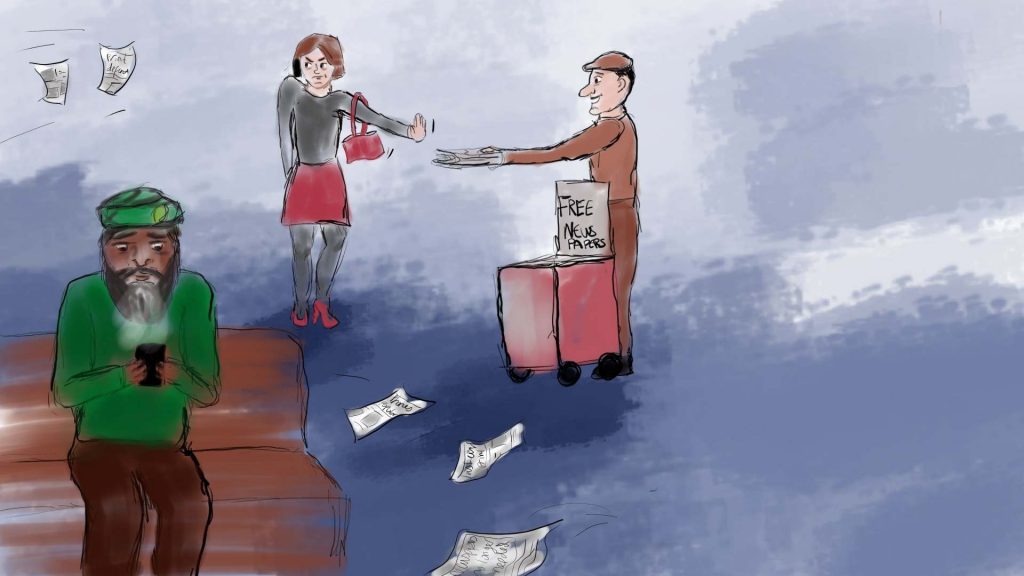illustration by Amelia Jabry
Print journalism is dying. Newspaper circulation is plummeting across the board. The Sun, the best-selling newspaper in the UK, recorded a 12% year-on-year decline in circulation in August 2019. The Guardian’s circulation is down 5% from last year, and The Telegraph’s readership has crashed by 15% in the same period.
The free papers aren’t faring any better. The Evening Standard and City AM saw readership fall by 5% and 9% respectively over the last year. Regardless of cost, the public are clearly dissatisfied with print journalism.
Some would say that this is a natural consequence of the digitisation of the media. With a 24-hour news stream at our fingertips, it’s no wonder we’re not waiting for the first editions to hit the streets every morning. What’s more, with so many news websites removing online paywalls in recent years, the idea of paying for a newspaper seems anachronistic when one can access live news for free at the touch of a button.
However, this analysis fails to tell the full story. Private Eye, a print-only monthly publication, has held its readership relatively firmly compared to the major publications. It recorded a modest 1% decline in circulation between June 2018 and June 2019 after recording a record readership in 2016.
The Spectator has also avoided the fate of many of its competitors. Its circulation reached an all-time high in the latter half of 2018, with 7% readership growth from the first half of the year. The Spectator’s online service, which sits behind a subscription fee, has flourished too, growing 50% in the last 10 years.
Furthermore, if the decline of print journalism were the result of the migration of audiences online, would books not suffer the same fate? When Amazon first released the Kindle in 2007, many predicted the death of physical books at the hands of the e-book – this proved to be nonsense. 2018 saw the fourth consecutive year of growth in UK print book sales, and this growth shows no signs of stopping.
The fact of the matter is that the failure of the print news industry cannot be so easily attributed to changing consumer preferences. The performance of The Spectator, Private Eye and physical books demonstrate that the British public are not exclusively wedded to digital media.
It’s certainly true that the news landscape has changed, with online news sources beating print at every turn and threatening to overthrow television as the UK’s predominant source of news. A 2018 Ofcom study found that the Internet accounts for 64% of our news intake; for those aged between 16 and 24 this figure rises to 82%.
It’s not difficult to understand this trend. Online news and social media sites can disseminate breaking news within seconds. Live sports reporting and news updates increase the quality of the online offering, not to mention the convenience of being able to access all of this at the press of a button. Physical newspapers, on the other hand, are cumbersome and slow ways to stay informed – waiting for the morning press to stay abreast of the latest news has become incomprehensible.
However, news executives can’t just sit on their hands bemoaning changing consumer preferences in the digital age if they want to survive. Inaction will kill the newspaper. Instead, they need to cast aside their commitment to news altogether.
The Spectator and Private Eye are flourishing because of their slow-roll approach to current affairs. Instead of publishing a daily dross, The Spectator focuses on quality. Each edition is a curated collection of articles which provide nuanced and informed commentary on current affairs. The editors at The Spectator know that you’ve read the news already. You’re buying their paper because you want to enjoy journalism, and they reward this.
Private Eye takes this to a whole other level. Published fortnightly, Private Eye is a razor-sharp take on the month’s news. Each paper is oozing with satire and packed with a variety of carefully constructed articles and cartoons. The approaches taken by The Spectator and Private Eye represent the only way forward for print journalism. This current model is doomed to failure. Print can never keep pace with the Internet’s ability to give the public minute-by-minute news updates.The industry should stop trying. Instead, print should become a more literary experience. Articles should be longer, more lovingly crafted and more carefully selected to give the audience a taste of true journalistic quality in each and every edition. Breaking news should be an online game and print should be reserved for comments on current affairs for an already-informed audience. For print journalism to survive, it has to kick out the new and embrace the old.



